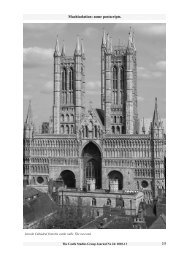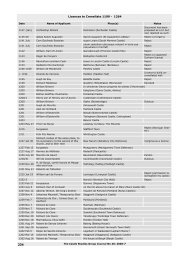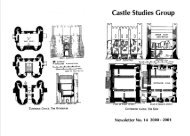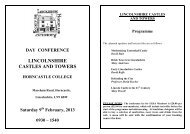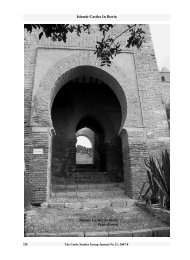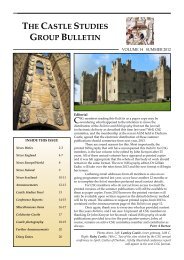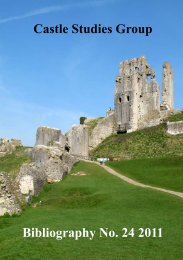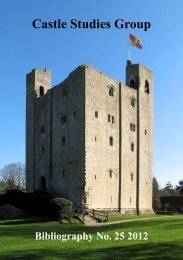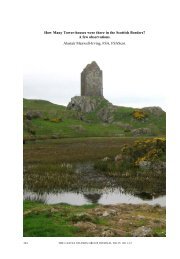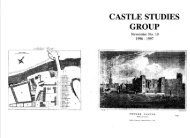Castle Studies Group Bibliography No. 22 2009
Castle Studies Group Bibliography No. 22 2009
Castle Studies Group Bibliography No. 22 2009
Create successful ePaper yourself
Turn your PDF publications into a flip-book with our unique Google optimized e-Paper software.
and display in the secular world as a whole, with sections on the hall, apartments, the castle andthe great tower. Amongst the features at the end of the chapter is a piece by Richard Fawcett onStirling <strong>Castle</strong>. This is a superb book, well worth acquiring, and much pleasure can found ineither dipping into it or reading it more thoroughly.With <strong>2009</strong> being hailed as the year of King Henry VIII, Heritage Today has a feature on theHenrician forts of the 1540s, written by Nigel Jones. Tom McNeill has looked at some keydevelopments in castle studies, such as the dendrochronological studies that have revised ourthinking of Chepstow and Loches, and has stressed that a single line of architecturaldevelopment in castles will not work, whether motte or stone castle. In his concludingparagraph in this Château Gaillard paper, Tom states: ‘Neither the old certainty of militarypurpose nor the newer assertion of display and status get to grips with the complexity of thedaily life of the community occupying the castle which we see now. We have to face the publicor our funding masters who ask the simple question: what was a castle for? The answer is thatthis is a question we cannot answer en masse, for each castle represented a different agenda.Removing the simple chronological narrative … liberates us as researchers but it leaves [us]unable to give a simple answer to what is in fact a very complex question.’The perception of the castle in nineteenth-century Ireland is the subject of a paper by ConManning, emphasizing that the term ‘castle’ meant different things to the varying strata of Irishsociety. In the latest Château Gaillard Jean Mesqui, Derek Renn and Laurens Smals havelooked at the portcullis in great towers, following the study of Heenvliet, built 1230, whichshowed that it had a ground-floor entrance with a portcullis. The earliest surviving example ofsuch a feature in great towers is possibly that at Colchester, dating to the late eleventh century,and the evidence for other examples in great towers are detailed in this paper.Marc Morris highlights various castles in a BBC History Magazine publication, Historicdays out. Kieran O’Conor in Château Gaillard suggests avenues of research in Irish castlestudies, including the long-term excavation of a motte and bailey. He uses the fine castle ofRoscommon as an example where the architecture has to be interpreted both in the military andthe domestic senses in order to fully understand the monument. Richard Oram, in the samevolume, examines the study of the castle in Scotland, how it has developed and the agenda forfuture work, where function rather than form becomes the order of the day.Richard also has a paper in Antiquaries Journal, a review and critical revision of lordly androyal residence in Scotland from around 1050 to about 1250. Again this is part of the movementaway from the militaristic approach that has tended to characterize studies in the past. ‘Focusedfieldwork and targeted research excavation’ are needed to be linked with the current work ofdocumentary historians, especially as the studies of the latter can be seen as fresh andinvigorating, whilst medieval archaeology needs to break out from its later twentieth-centuryframework.The use of reconstruction drawings to assist in the interpretation of ancient monuments,whether on site or in guidebooks, is featured in an article by Louisa Sherman and SusanWestlake of English Heritage in an issue of Interpretation Journal, and the two sites featuredare Grime’s Graves and Ashby de la Zouche <strong>Castle</strong>.Sarah Speight’s paper in the last CSG journal is a development of the paper she gave at theChâteau Gaillard conference in 2006; this was an examination of castles in the EnglishMidlands in the post-medieval period, whether as centres of leisure, income generators, etc. Forthe benefit of those following up references in the CSG paper, please note that for Austen readAustin, and for O’Keefe read O’Keeffe.6



